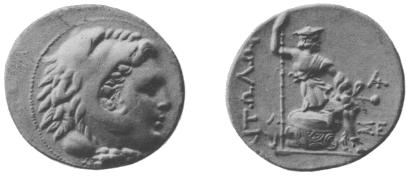
FIG. 189.



[British Museum Catalogue of Greek Coins, Thessaly to Aetolia, by P. Gardner, 1883.]
The Aetolians, notwithstanding their ancient heroic fame, were in historical times the most turbulent and uncivilized people of Hellas. Before the age of Alexander there is no trace of Aetolian money, nor was it until after the consolidation of the Aetolian League, brought about by the invasions of Aetolia by the Macedonians (B.C. 314-311) and by the Gauls (B.C. 279), that the Federal coinage began.
This is proved by the reverse type of the tetradrachm, which contains a distinct allusion to the repulse both of Macedonians and Gauls by the Aetolians.
| Head of Athena in Corinthian helmet. [Brit. Mus. Guide, Pl. XLII. 14.] |
ΑΙΤΩΛΩΝ Aetolia [1] wearing kausia,
short chiton, chlamys, and endro-
mides, with sword and spear, seated
on pile of shields, her left breast
bare; she holds Nike. AV Stater.
|
| Head of young Herakles in lion-skin. | ΑΙΤΩΛΩΝ Id. [Brit. Mus. Guide,
Pl. XLII. 15]. AV ½ Stater.
|
| Head of Aetolos in kausia. [Hunter, Pl. XXXII. 13.] |
ΑΙΤΩΛΩΝ Kalydonian boar; in ex-
ergue, spear-head. AV ½ Stater.
|
It seems absolutely certain that the first of the Aetolian gold staters, which is of much more elegant and refined workmanship than the rest, was, like those of Pyrrhus, designed, engraved, and struck at the Syra- cusan mint. Cf. B. M. C., Thes., Pl. XX. 7 (Pyrrhus) with Pl. XXX. 3 (Aetolia); the two are almost identical on the obverses, and bear the same adjunct symbol, an owl, behind the head of Athena.

1 Concerning the old attribution of this figure to Atalanta and of that of Aetolos to Meleager, see Imhoof (Mon. gr., p. 145).
| Head of young Herakles in lion-skin. | ΑΙΤΩΛΩΝ Aetolia seated as above,
but without Nike (Fig. 189).
AR Attic tetradr.
|
| Bust of Artemis laur., with bow and quiver at her shoulder. | ΑΙΤΩΛΩΝ Id. AR Attic tetradr.
|
| Young male head, wearing wreath
intertwined with diadem. [Brit. Mus. Guide, Pl. XLII. 17.] |
„ Naked warrior (Aetolos)
with kausia hanging at his back and
sword under his arm, standing rest-
ing on spear with one foot on rock.
AR 158 grs.
|
The head on the coins of the last series has been conjecturally identified by Gardner (N. C., I 878, p. 97) with that of Antiochus III, who, during his invasion of Greece, B.C. 192-191, was elected αυτοκρατωρ στρατηγος of the Aetolian League; see, however, N. C. 1894, pp. 297 ff., where J. P. Six suggests that it is more likely to be a portrait of Demetrius, son of Antigonus Gonatas, surnamed ‘Aetolicus'.
| Head of Artemis laureate, with bow and quiver at her shoulder. | ΑΙΤΩΛΩΝ Aetolia seated on shields
[Brit. Mus. Guide, Pl. XLII. 18]
AR 82 grs.
|
| Head of Athena in Corinthian helmet. | ΑΙΤΩΛΩΝ Boar and spear-head [Im-
hoof, Mon. gr., Pl. D. 18] AR 87 grs.
|
| Head of Aetolia wearing kausia. | ΑΙΤΩΛΩΝ Kalydonian boar; in ex-
ergue, spear-head [B. M. C., Pl. XXX.
8]. AR 41 grs.
|
| Head of Aetolos, hair short, wearing kausia. | ΑΙΤΩΛΩΝ Id. AR 38 grs.
|
| Head of Aetolia. | ΑΙΤΩΛΩΝ Id. Æ .7
|
| Id. | „ Spear-head. Æ .7-.6
|
| Young male head, Aetolos (?), laureate. | „ Trophy [B. M. C., Pl. XXX.
11]. Æ .7
|
| Id. | ΑΙΤΩΛΩΝ Club. Æ .45
|
| Id. [B. M. C., Thes., Pl. XXX. 12.] | „ Spear-head and jaw-bone
of Kalydonian boar. Æ .7
|
| Head of Athena. [B. M. C., Thes., Pl. XXX. 13.] |
ΑΙΤΩΛΩΝ Herakles standing.
Æ .75
|
The seated figure of Aetolia on some of the above coins is certainly a copy of the statue of that heroine dedicated by the Aetolians at Delphi, γυναικοσ αγαλμα ωπλισμενης, η Αιτωλια δηθεν (Paus. x. 18. 7), in memory of their victory over the Gauls. Beneath her feet on the tetradrachms is a Gaulish trumpet (carnyx) ending in the head of a wolf or dragon, and some of the shields on which she is seated are of the Gaulish and others of the Macedonian pattern, the former sometimes inscribed Α, the initial of the Gaulish leader Acichorius, and the latter ΛΥ, perhaps standing for Lyciscus, the Macedonian general (B. M. C., Thes., p. lvii).
None of the Aetolian towns issued autonomous coins. The few bronze pieces with Aetolian types were probably struck by cities in alliance with the Aetolians outside the boundaries of Aetolia proper, or not actual members of the Confederacy, such as Oeta in Thessaly, Amphissa, and Oeantheia in Locri Ozolae, Thronium in Locri Epicnemidii, and Apollonia near Naupactus. (Cf. also Hunter Cat., II. 30.)